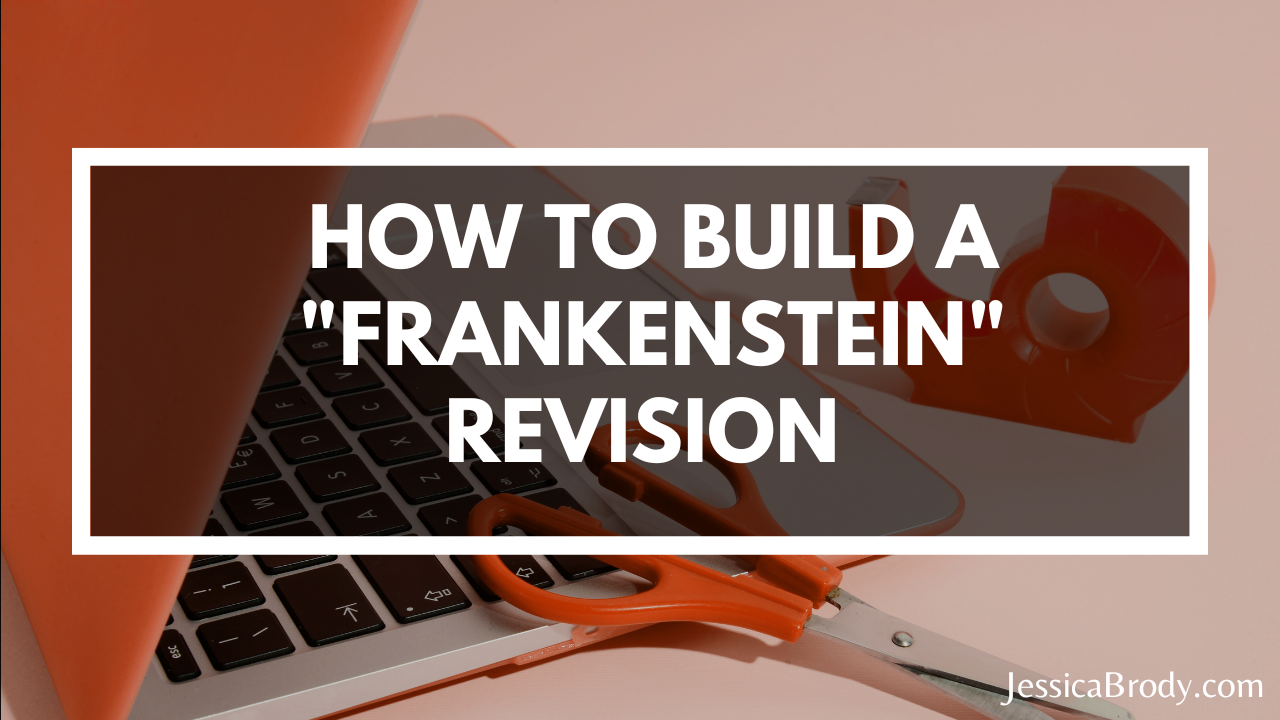How to Build a “Frankenstein” Revision

Revising can be messy. As someone who thrives on order and checklists and clean documents, unmarked documents, I’ve never liked how messy the revision process can feel. You’ve got tracked changes turning your pages into Jackson Pollack painting, comments cluttering up the margins, unfinished subplots dangling about, and torn-apart scenes strewn through your manuscript like debris after a hurricane.
I. DON’T. LIKE. IT.
That’s why I invented the Frankenstein revision. (Okay, so I probably didn’t really invent it. For all I know it’s been around since Mary Shelley herself.) But I’ve come to love it. So I thought I’d share it with you, just in case you too, suffer from messy-manuscript-phobia.
Since “inventing” it, it’s become one of my favorite things ever and I rarely revise a manuscript any other way (at least not for the first few drafts when things are getting shuffled around the most.) I even recently used it for revising the second draft of my upcoming non-fiction book, Save the Cat! Writes a Young Adult Novel.
Why is it called a Frankenstein revision? Well, what do you first think of when I tell you to picture Frankenstein’s monster? I, personally, think of mismatched body parts stitched together. And that’s what this revision is. Instead of revising or rewriting your manuscript in your existing document, you stitch various parts together in a new document.
Here’s a step-by-step breakdown of how I do it.
(Hint: this method works best if you have more than one monitor, but you can achieve the same results by splitting your single monitor into multiple windows).
Step 1: Open Your Current Draft
Open your first (or current) draft on one screen or window. This will be what you pull text from. This should not change or be edited at all. Think of it as “locked.”
Step 2: Open a Separate Blank Document
Open a brand-new, blank document on a second screen or window. This will become your next draft. Name it something that will help you identify it. Like “[Book title] – Second Draft” or “[Book Title] – Frankenstein Draft”. I actually like to name my files, “[Book Title] – Second Draft Rebuild” (for reasons that will make sense in the next step.
3) Rebuild Your Story
As you work through your revision plan, you’ll be copying and pasting sentences, paragraphs, or maybe even full scenes from your first document (current draft) into your second document (next draft). This text may or may not appear in the same order in your next draft, which is why it’s helpful to have the full, intact current draft document open on another screen so you can pick and choose what to pull in and when.
Any sections that don’t yet exist in your current draft, but need to be added to the next draft, can be written in as you go. These can be full scenes, subplots, new threads, or even just a chunk of dialogue.
I personally like to start at the beginning of my next draft and work through the story chronologically, copying and pasting parts that I do have and writing in parts that I don’t have. I essentially rebuild my story based on the next-draft storyboard I’ve created in my revision plan.
Don’t have a revision plan yet? Build yours here with my Complete Novel Revision Course!
4) Stitch Things Together as Necessary
As you rebuild your story, you’ll probably find that the text doesn’t seamlessly fit together piece by piece, especially when you’re rearranging a lot of scenes. You’ll probably need to add some “stitching” in places to make story flow properly.
For example, if you’ve pulled a scene from near the end of the first draft and are now putting it closer to the start of the novel, you’ll probably need some timeline “stitching” to make it work sequentially, and possibly some tweaks to the actual scene to remove any references to plot points or events that haven’t happened yet or characters who haven’t been introduced yet.
5) Continue Building and Stitching Until You’re Finished
Repeat steps 3-5, copying and pasting from your current draft into your new draft, adding in new text when necessary, and fusing it all together until you’ve worked through your revision plan and your next draft is complete.
Now you have a “Frankenstein” revision! You’ll probably have to go back through it a few more times to make sure that stitching really is seamless and there’s no unsightly limbs hanging out where they shouldn’t be.
I find this method to be so much more organized and controlled and it helps me gauge where I am in the process at all times because I’m literally rebuilding my story anew.
Also, copying and pasting from my current draft, instead of trying to revise in the draft, helps me see the story more clearly and makes it easier for me to let things go that really don’t serve my next draft. It’s so much harder to deletesomething from your draft than it is to simply not add it into the next draft. It’s sort of a psychological trick. Deleting makes it feel like you’re erasing hard work. Leaving it in the old draft and choosing not to copy and paste it into the new draft just reminds us that it’s still there, and it has a place…in the old draft. But not necessarily in the new one.
So, if you’re looking to shake up your revision process, try the Frankenstein method with your next draft and see if it helps you tackle that revision monster once and for all!

Filed under: Tips for Writers Writing Mastery Tagged with: fiction writing novel revision novel writing revising revising hacks Revision course (LMAP) revisions Tips for Writers writing hacks writing mastery writing tips writing tools